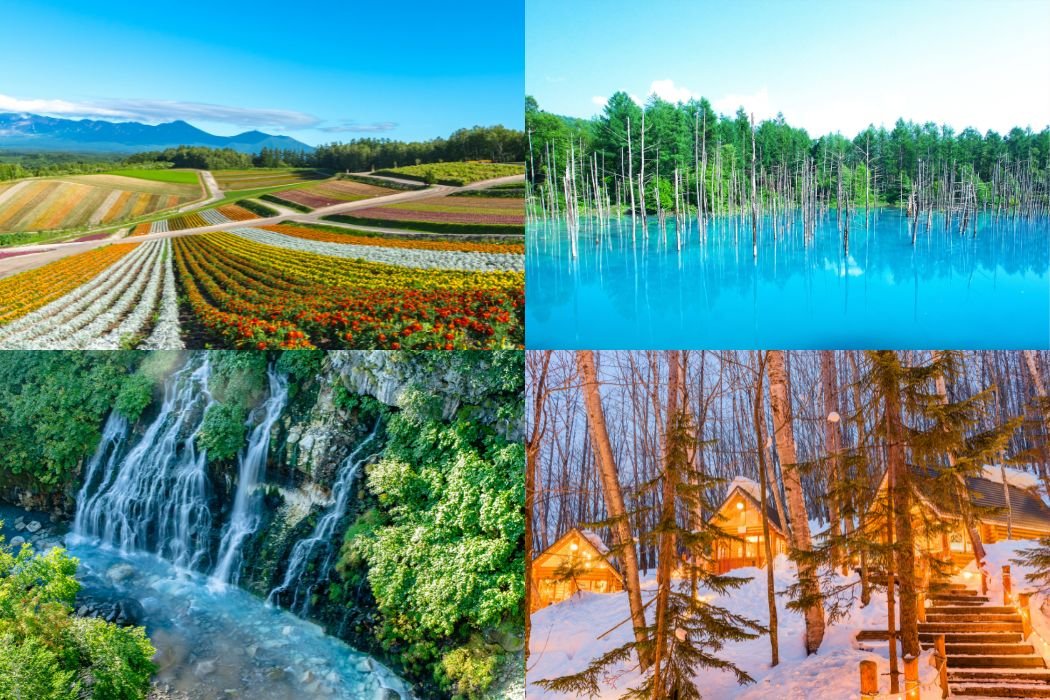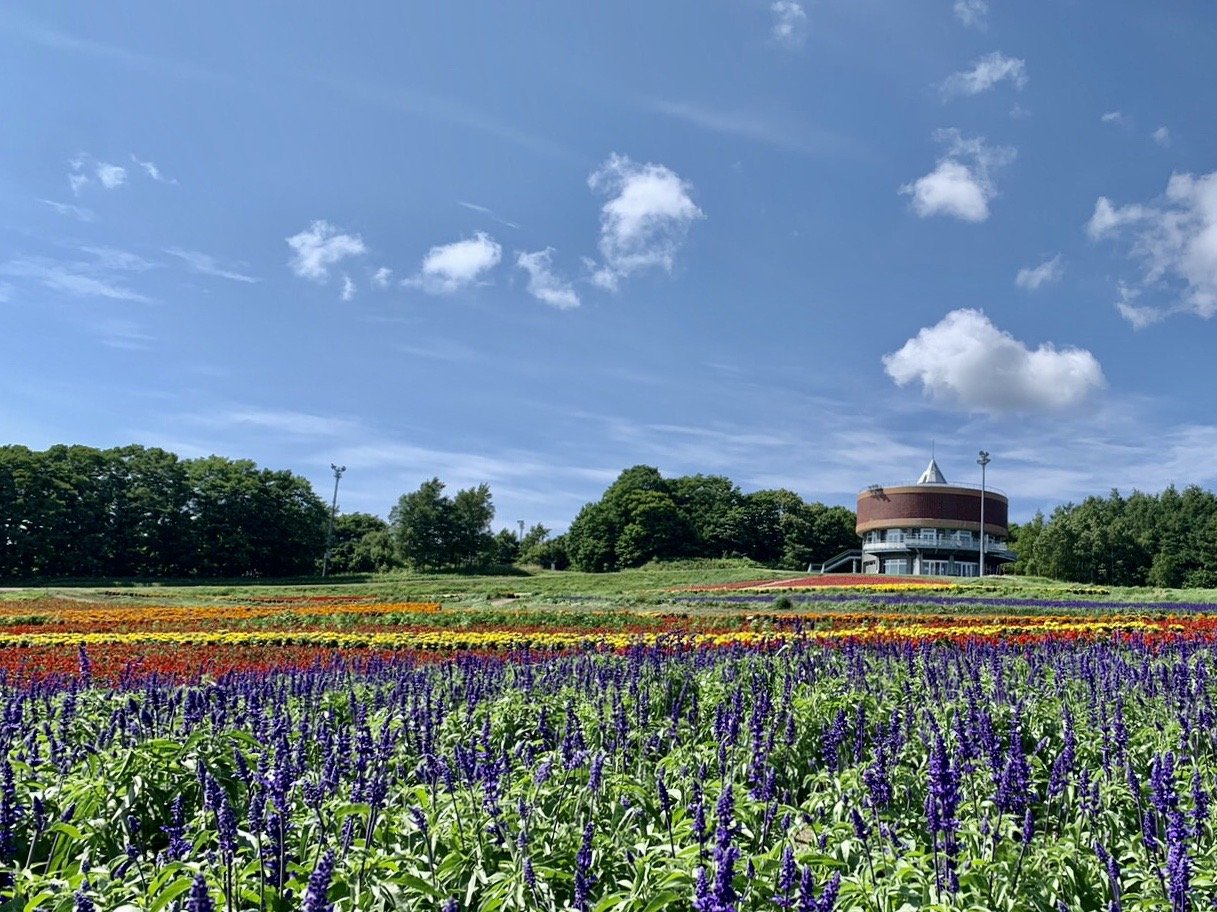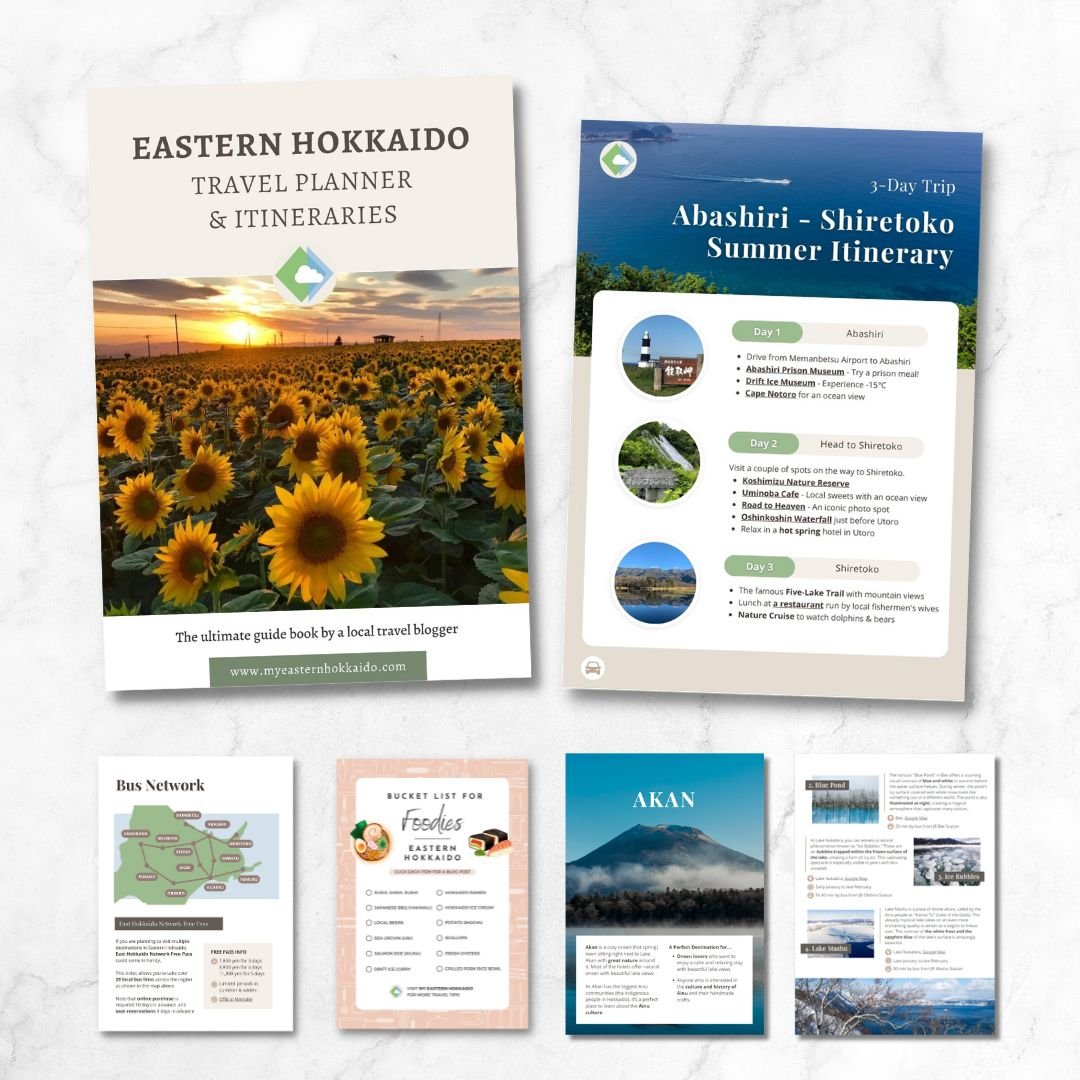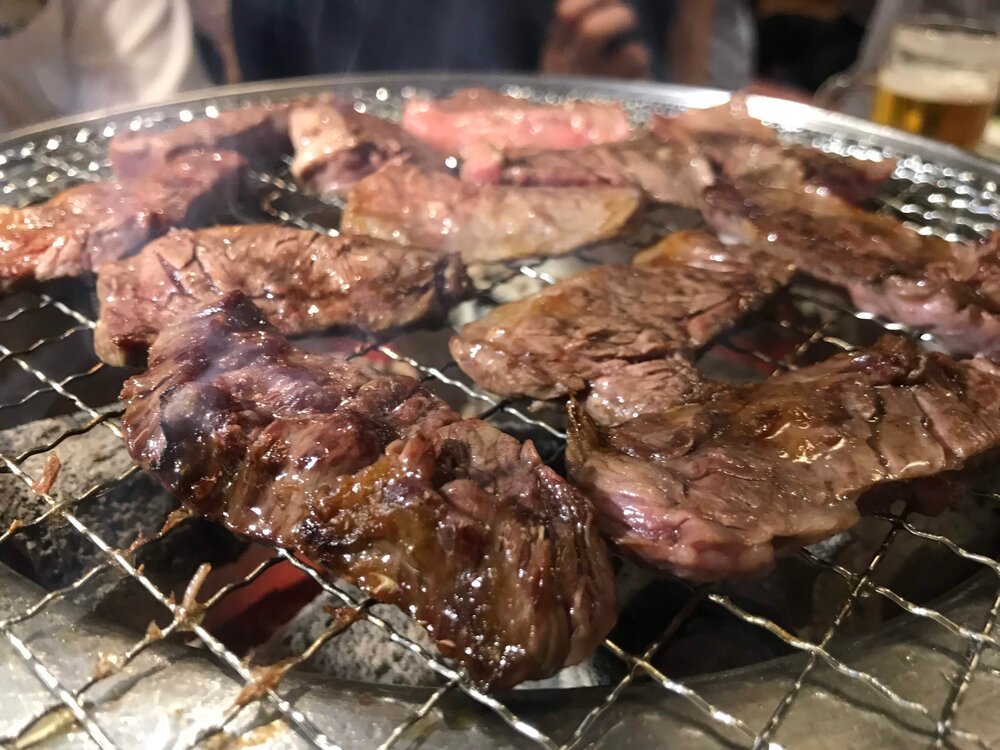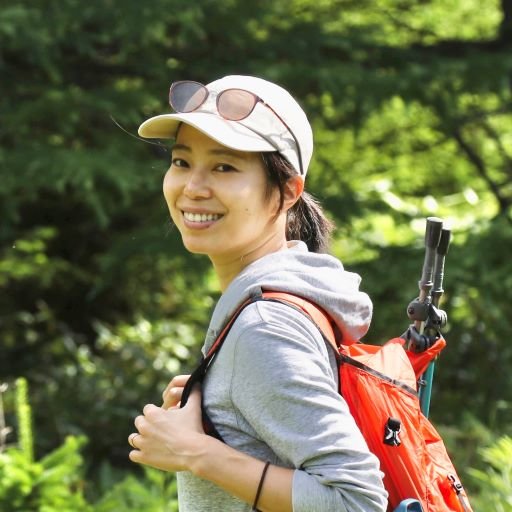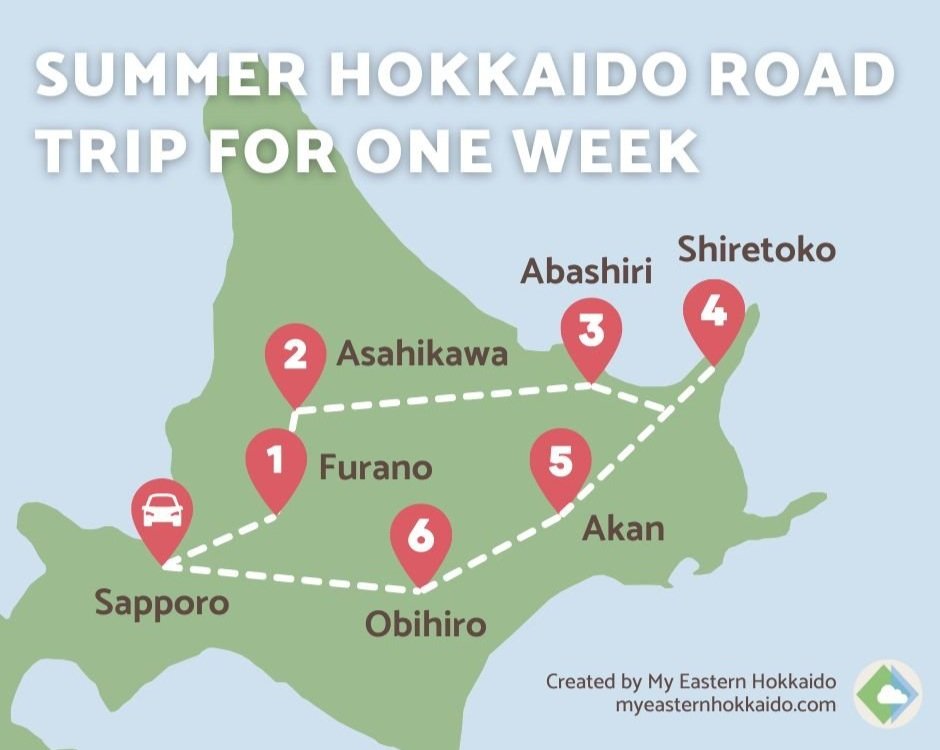Hokkaido is huge, and it has so many attractive places to choose from.
Are you feeling overwhelmed and don’t know where to go?
No worries. As a local who’s traveled around Hokkaido for over 20 years, I’m here to help you decide the best destinations for your trip.
In this guide, I will walk you through 12 major destinations in Hokkaido. You will learn everything you need to know about each place, from things to do, local food and day trip ideas to recommended hotels.
Don’t miss the FAQ at the end! I will answer some of the most common questions I received from over 100 travelers I helped with their itineraries. There’s a good chance your question is covered too.
Now, let’s find the Hokkaido destinations you’ll love!
Table of content
- Overview: The best places to visit in Hokkaido
- Central & Northern Hokkaido
- Sapporo
- Otaru
- Furano & Biei
- Asahikawa
- Eastern Hokkaido
- Abashiri
- Shiretoko
- Akan
- Lake Kussharo & Lake Mashu
- Kitami
- Kushiro
- Obihiro
This post contains affiliate links that at no additional cost to you, I may earn a small commission to enjoy a cup of coffee on my trip☕
Overview: The best places to visit in Hokkaido
Japan's northernmost island, Hokkaido is known for its beautiful landscapes, fresh seafood and produce, outdoor activities, onsen hot springs and many more.
If you are planning a trip to Japan and visiting busy places like Tokyo and Kyoto (or anywhere in the rest of Japan!), Hokkaido is a great destination to add to your itinerary.
Here’s a quick overview of the places that I recommend for different types of travelers. Which one are you?
For nature lovers: Shiretoko, Akan, Lake Kussharo & Lake Mashu area
For onsen lovers: Akan, Utoro, Noboribetsu, Lake Kussharo
For foodies: Sapporo, Obihiro, Kitami, Hakodate
For families: Sapporo, Asahikawa, Abashiri, Hakodate
For culture & history lovers: Sapporo, Abashiri, Hakodate
For non-drivers: Sapporo, Otaru, Hakodate, Asahikawa
Now, let’s look into each destination.
Central & Northern Hokkaido
These most-visited regions of Hokkaido include Sapporo, Otaru, Furano, Biei and Asahikawa. From vibrant city experiences to Hokkaido’s beautiful nature landscapes, you can enjoy a little bit of everything here.
Here are some of my favorite itineraries in this region.
Sapporo
Sapporo is the biggest city and the capital of Hokkaido, home to nearly 2 million people. It has a good mixture of touristy spots and local gems that can be found in the city life. There are plenty options for shopping, restaurants, cafes and izakaya (Japanese-style bars).
The city provides many seasonal attractions as well, such as Sapporo Summer Festival, Sapporo Snow Festival, and many spots for cherry blossom and autumn leaves across the city.
It is also the travel hub — the main airport of Hokkaido, New Chitose Airport is nearby. You can access most of other major Hokkaido cities by direct train, bus or flight. Whether you are going on a road trip across Hokkaido (<- my itinerary alert!) or traveling by public transportation, Sapporo would be a good starting and/or ending point of your trip.
You can also make day trips to Otaru, Jozankei, Lake Shikotsu, Lake Toya and Niseko, while staying in Sapporo.
Sapporo has a good transportation system within as well. You can take metro and buses to most of the tourist spots. You won’t need a car to get around. In fact, parking is not cheap in the downtown area, so I recommend taking public transportation or taxi.
Highlights in Sapporo
Odori Park: A long, greeny park stretching through downtown Sapporo loved by locals.
Shiroi Koibito Park: A chocolate-themed park where you can tour the factory and enjoy sweets workshops.
Sapporo Beer Museum: A historic museum celebrating Japan’s oldest beer brand, with exhibits on brewing history and an option for tastings.
Sapporo Snow Festival: Japan’s biggest snow festival in early February, featuring massive snow and ice sculptures and many events and food stalls.
Sapporo Summer Festival: A lively summer event with outdoor beer gardens, traditional performances, and seasonal food stalls throughout Odori Park.
What to eat in Sapporo
Sapporo miso ramen: Sapporo is the birthplace of miso ramen. Thick, wavy egg noodles are often used to match the nutty, sweet flavor of miso.
Jingisukan: Hokkaido-style mutton/lamb BBQ grilled on an iron plate
Soup curry: Sapporo’s signature curry soup with large toppings like vegetables and meat
How to get to Sapporo
By flight: Fly into New Chitose Airport (CTS). From the airport, you can take the JR Rapid Airport train to Sapporo Station, about 40 minutes.
By train: While there is no direct Shinkansen (bullet train) service to Sapporo, you can take the Shinkansen from Tokyo to Hakodate and then transfer to a limited express train to Sapporo. The total trip takes 8 hours.
How many days to stay in Sapporo
3 days & more if you do day trips from Sapporo
Where to stay in Sapporo
- JR Tower Hotel Nikko Sapporo
⭐4 stars ♨️Hot spring 🏢Excellent Location
An urban city hotel with a great location directly connected to JR Sapporo station, shopping malls nearby, and a natural hot spring spa. Only 10 min walk to Odori Park. - ONSEN RYOKAN Yuen Sapporo
⭐3.5 stars 👩❤️👨For Couple ♨️Hot spring
A modern onsen city hotel with simple and stylish rooms, located just 5 min away from Odori Park. - Mercure Hotel Sapporo
⭐4 stars 🏢Excellent Location 👟Fitness Room
A city hotel conveniently located in Susukino, a popular spot for local restaurants and bars.
>>> More hotel suggestions in Sapporo
Otaru
Otaru is a charming port city near Sapporo, facing the Sea of Japan. It is known for its beautiful well-preserved canals, historic architecture, and glasswork shops.
It's a popular destination for its scenic views and fresh seafood and makes a great day trip from Sapporo.
Highlights in Otaru
Otaru Canal: A historical canal surrounded by classical architecture. Enjoy shopping nearby or take a canal cruise.
Otaru Snow Light Path Festival in mid-February.
Mount Tengu: Take a ropeway up to the top of the mountain. There are observatories, a shrine, and a chipmunk park where you can buy sunflower seeds to feed them. If you want a quick 30-min hike, you can go on a 1.6 km loop trail going through the mountain summit
What to eat in Otaru
Sushi: Otaru is known for its high-quality sushi. There are many long-established restaurants across the city.
LeTao's cheesecake: Otaru’s signature local sweets shop. Their fluffy cheese cake is a must-eat.
How to get to Otaru
By car: Drive about 30 min via highway from Sapporo and one hour from New Chitose Airport
By train: Take a train from JR Sapporo Station, abut 40 minutes
How many days to stay in Otaru
1-2 days
Where to stay in Otaru
- Grand Park Otaru
⭐4 stars, 👀 Beautiful View, 🛍️ Shopping
A seaside resort hotel, directly connected to a shopping mall, Wing Bay Otaru. - Hotel Nord Otaru
⭐3 stars, 🏢Excellent Location, 👀 Beautiful View
A classic, elegant Western-style hotel located right in front of the Otaru Canal, 7 min walk from JR Otaru Station. - Dormy Inn Premium Otaru
⭐3 stars, ♨️Hot Spring, 🍴Great Breakfast
A city hotel offering a natural hot spring and a popular breakfast buffet including fresh seafood.
Furano & Biei
Known as their colorful flower fields, Furano and Biei are often said the must-see destinations of Hokkaido. Many tourists from both within and outside Japan visit here for picturesque sceneries and farms.
Since local businesses here are used to welcoming international visitors, this area is easy to travel for first-timers in Hokkaido as well as families with kids (<- my itinerary alert!).
You can also get around this area without a car (<- my itinerary alert!).
That being said, if you don’t like crowds, or if you’re looking for less touristy experiences, you can definitely skip this area (or at least try to visit more hidden local spots).
If you want to ski or do some winter sports, Furano is a great option. The surrounding area is well known for its quality powder snow. Many hotels have either direct access to the ski resort or provide free shuttle services. You can find ski lessons for beginners if you’re just starting to learn ski.
Highlights in Furano & Biei
Farm Tomita: A popular flower farm in Furano, known for vibrant lavender fields and many other seasonal flowers.
Furano Marche: A local market featuring stalls of fresh produce, bakeries, cafes, and handcrafted goods.
Furano Cheese Factory: A fun place to lean about the cheese-making process, try cheeses made from locally sourced milk, and join workshops to make butter and ice cream.
Shikisai no Oka: A panoramic flower garden in Biei overlooking hills filled with colorful flowers and offering tractor rides for a unique viewing experience.
Shirahige Waterfall: A beautiful waterfall cascading white streams into River Biei, as known as Blue River.
Shirogane Blue Pond: A magical blue pond, one of the most visited attractions in Hokkaido.
What to eat in Furano & Biei
Furano Melon: Furano’s speciality in summer! Many local farms offer juicy, sweet melons in and around the city.
Furano Wine: Known for its robust acidity and full-bodied flavor, using locally grown grapes.
Omu Curry: Furano’s local dish, omu rice with curry sauce.
How to get to Furano & Biei
By train: From Sapporo, take the JR Limited Express “Lilac” or “Kamui” to Asahikawa Station (1.5 hours), then transfer to the JR Furano Line for Biei (30 minutes) or Furano (1 hour).
By car: From Sapporo, drive 2 hours to Furano and 2.5 hours to Biei. From Asahikawa, Biei is 40 minutes, and Furano is 1 hour away.
By bus: From Asahikawa Airport, Lavender Bus runs to both Biei (15 min) and Furano (1 hour).
By flight: Asahikawa Airport is the nearest airport.
How many days to stay in Furano & Biei
3 days
Where to stay in Furano
- La Vista Furano Hills Natural Hot Spring
⭐4 stars, 🏢Excellent Location, ♨️Hot Spring, 🍴Great Breakfast
Mountain view city hotel with hot spring - Shin Furano Prince Hotel
⭐4 stars, 🏢Excellent Location, ♨️Hot Spring, 👨👩👧For Family
Prime location for Furano adventures - Furano Natulux Hotel
⭐4 stars, 🏢Excellent Location, ✨Modern Design, 👩❤️👨For Couple
Cozy hotel near JR Furano Station, perfect for a relaxing stay
>>> More hotel suggestions in Furano
Asahikawa
Asahikawa is the second biggest city in Hokkaido. Similarly to Sapporo, there are many restaurants, izakaya and shops.
As the city has Asahikawa Airport and JR train station, it’s a gateway to the popular tourist places, Furano and Biei. If these are your main destinations, starting from Sapporo, it’s a good idea to stop by Asahikawa on the way, like this 5-day itinerary.
Asahikawa is also next to Daisetsuzan National Park, the largest national park in Japan. From Asahikawa, you can make day trips to Mount Asahidake and Sounkyo, an onsen town in a valley at the bottom of Mount Kurodake. Ropeway services are available for both mountains so you can enjoy the view and hiking.
If you are visiting Asahikawa in winter, make sure to layer up. It’s one of the coldest places in Hokkaido!
Highlights in Asahikawa
Asahiyama Zoo: A famous zoo offering about 30 immersive exhibits that allow close-up views of animals. Tips on how to explore the zoo are here.
Ueno Farm: A charming English-style garden featuring a variety of seasonal flowers and plants, perfect for strolls and taking photos.
Heiwa Shopping Street: A vibrant pedestrian street with shops, cafes, and restaurants, loved by locals as a central hub for shopping and dining.
Asahikawa Winter Festival: A big winter festival in early February, showcasing snow and ice sculptures, illuminations, and family-friendly activities.
What to eat in Asahikawa
Asahikawa shoyu ramen: Asahikawa’s signature ramen with soy sauce-based and medium-thick, wavy noodles.
Shinko Yaki: Local’s favorite grilled half chicken marinated in a flavor unique to each shop
How to get to Asahikawa
By flight: From Tokyo, take direct flights from Haneda Airport, about 1 hour and 40 minutes.
By train: From Sapporo, take the Limited Express “Lilac” or “Kamui” trains, about 1.5 hours.
By bus: From Sapporo, take Express buses are available between JR Sapporo Station and JR Asahikawa Station, about 2 hours. The bus ticket is cheaper than trains.
By car: From Sapporo, drive via the Hokkaido Expressway, about 2 hours.
How many days to stay in Asahikawa
2 days for Asahikawa + a couple more days for day trips
Where to stay in Asahikawa
- HOTEL AMANEK Asahikawa
⭐4 stars, ✨Modern Design, 🏢Excellent Location
A newly-built modern hotel located 5 min walk from JR Asahikawa offering a public bath with a view. - OMO7 Asahikawa
⭐3 stars, ✨Cool Interior Design, 🍴Great Breakfast
A casual and modern hotel by Hoshino Resorts, a high-end hotel brand in Japan. Many local restaurants, cafes, and bars are within walking distance. Family rooms available. - Dormy Inn Asahikawa
⭐3 stars, ♨️Hot Spring, 🍴Great Breakfast
A city hotel located 10 min walk from JR Asahikawa, with a natural hot spring and great breakfast buffet.
Eastern Hokkaido
Eastern Hokkaido is a nature wonderland (and it’s my hometown region!). I recommend visiting here to anyone looking for untouched nature and outdoor adventures in more rural areas.
This region includes Abashiri, Shiretoko, Akan, the Lake Kussharo and Lake Mashu area, Kushiro, Kitami and Obihiro.
My favorite itineraries in this region are;
Useful Resources
✨Traveling to Eastern Hokkaido? Grab my Eastern Hokkaido Travel Planner
✨Planning a winter trip? Check out my Winter Hokkaido Travel Planner
✨Stuck in your trip planning? Ask for my Local Expert Advice
Abashiri
Abashiri is a port city on the coast of the Sea of Okhotsk. It’s a great destination both in summer and winter (<- my itinerary alert!) as well as for a family trip, offering many child-friendly activities in and around the city.
Abashiri has some unique local museums, lakes, and nature reserves nearby. In winter, drift ice is the must-see attraction that you don't want to miss.
As it’s located close to Memanbetsu Airport, I would recommend stopping by Abashiri as the first destination of your trip to Eastern Hokkaido. While staying in Abashiri, you can also make a day trip to Monbetsu, Lake Saroma, or Shiretoko.
Highlights in Abashiri
Drift Ice Museum: An interactive museum where visitors can touch actual drift ice and learn about the Sea of Okhotsk’s unique nature.
Icebreaker Ship Aurora: A one-hour cruise that breaks through drift ice — a unique winter experience only from late January to late March.
Abashiri Prison Museum: A historical site showcasing the former prison buildings and exhibits of inmate life and prison history.
Lake Saroma: Hokkaido’s largest lake, famous for its breathtaking sunsets over the water.
Wakka Nature Center: A nature reserve sitting between the sea and Lake Saroma, offering bicycle rentals to explore diverse flora and fauna.
Koshimizu Nature Reserve: A coastal nature reserve that is rich in wildflowers.
Higashimokoto Shibazakura Park: A hilly park that turns into vibrant pink moss phlox in May, creating a stunning and photogenic landscape.
Cape Notoro: A scenic cape with an iconic lighthouse and panoramic ocean views.
Lake Notoro: The lakeside turns a beautiful deep red from mid-August to late September with Japan’s largest glasswort colony.
What to eat in Abashiri
Seafood: hairy crab from April to August, scallops from July to August
Gelato Rimo: delicious gelato using Abashiri milk and unique local flavors
Prison lunch: You can try what inmates used to eat back in the day at Abashiri Prison Museum.
How to get to Abashiri
By flight: Fly into Memanbetsu Airport. From the airport, you can take a bus to Abashiri, about 40 minutes.
By car: Drive 1.5 hours from Utoro, Shiretoko, or 2 hours from Lake Akan
By train: JR Abashiri station is directly connected with Asahikawa (4 hours), Kushiro (3 hours), Kitami (30 min) and Shari (20 min), the closest station to Utoro, Shiretoko.
How many days to stay in Abashiri
3 days in summer or 2 days in winter
Where to stay in Abashiri
- Hokuten no Oka Abashiriko Tsuruga Resort
⭐4 stars, ♨️Hot Spring, 🍴Great Buffet
A relaxing onsen resort hotel featuring the Ainu art in its well-designed interior. - Kagariya
⭐4 stars, ♨️Hot Spring, 🍴Great Buffet
An onsen ryokan with a lake view, offering seafood Kaiseki dinner and breakfast. - Dormy Inn Abashiri
⭐3 stars, 🏢Excellent Location, ♨️Hot Spring
A budget business hotel with 7-eleven nearby.
Shiretoko
Shoretoko is the place that I recommend to every nature lover to visit. It is a peninsula in Eastern Hokkaido, registered as a World Natural Heritage, with the Shiretoko National Park covering 2/3 of its land. Blessed with untouched nature, Shiretoko offers many outdoor activities in its diverse landscapes — the forests, lakes, waterfalls and the sea.
Utoro, a port town on the western side of the peninsula, is the center of nature tourism in Shiretoko. You can access most of the activities and tours here. Also, as a port town, of course it has great seafood.
Utoro is also a well-known onsen town. Relaxing in a natural hot spring while enjoying the ocean view… doesn’t this sound amazing?
You can find my Shiretoko itineraries for summer and winter here.
Highlights in Shiretoko
Shiretoko Five Lake Trail: A scenic trail through untouched forest and around five small lakes, offering stunning views of mountain range and wildlife.
Nature Cruise: A boat cruise along Shiretoko’s coast to spot dolphins, whales, and brown bears in their natural habitat.
Drift Ice Walk: A unique winter experience where you can walk on drift ice and even swim in the frozen sea.
Snowshoeing: A peaceful winter activity that lets you explore Shiretoko’s snowy landscapes and spot wildlife tracks.
Kamuiwakka Waterfall: A natural hot spring waterfall where you can enjoy an adventurous climb in a warm stream during summer (self-guided but booking required).
Oshinkoshin Waterfall: A beautiful, wide waterfall easily accessible by road, known for its powerful flow and photogenic views.
What to eatin Shiretoko
Sea urchin: best from January to June
Salmon & ikura (salmon roe): best from September to November
How to get to Shiretoko
By flight: Fly into Memanbetsu Airport. A seasonal bus Shiretoko Airport Liner runs to Utoro from June to September and from late January to early March, about 2 hours.
By car: Drive 2 hours from Memanbetsu Airport, 1.5 hours from Abashiri, and 2.5 hours from Lake Akan.
By train and bus: Take Shiretoko Airport Liner bus from Abashiri (2 hours), or take a train to JR Shiretoko-Shari Station, the closest station to Utoro, Shiretoko. From there, local buses run to Utoro and take about 50 minutes.
How many days to stay in Shiretoko
3 days in summer or 2 days in winter
Where to stay in Shiretoko
- Kita Kobushi Shiretoko Hotel & Resort
⭐4 stars, ♨️Hot Spring, 👀 Beautiful View
Located right in front of Utoro Port, offering deluxe room options with a private open-air hot spring. - Sekka Shiretoko
⭐3 stars, ♨️Hot Spring, 🧡Amazing Hospitality
A small family-run inn where the warm-hearted owner chef is committed to make homemade food with fresh local ingredients. - Hotel Kifu Club Shiretoko
⭐4 stars, ♨️Hot Spring, 🛁Private Onsen, 🍴Great Meals
A cozy family-run onsen hotel with an ocean view.
Akan
Akan is a small, cozy onsen town sitting right next to Lake Akan. This is one of my favorite destinations for a weekend trip. It offers natural onsen, beautiful lakes, and outdoor activities nearby.
What I like about Akan is that you can enjoy different sceneries in each season. In summer, the town is surrounding by rich, greenery forests where you can explore by hiking or taking a tour. The trees turn beautiful autumn colors in fall. In winter, Lake Akan gets frozen and people enjoy winter activities on the lake.
Akan is also home to the biggest community of the Ainu, the indigenous people of Hokkaido.
Check out my 3-day Akan itineraries for summer and winter here.
Highlights in Akan
Ainu Kotan: An Ainu village and cultural center where you can explore traditional craft shops, a museum, and theater exhibits dedicated to the Ainu, Hokkaido’s indigenous people.
Eco Museum Center: A nature-focused center showcasing exhibits on Akan’s diverse landscapes, including its forests, lakes, and volcanic activity.
Bokke Walk: A 1.5 km loop trail starting at the Eco Museum Center, leading to the steaming mud volcano, Bokke, a unique natural phenomenon in the region.
Snowshoeing: Rent snowshoes at the Eco Museum Center and explore the Bokke Walk during winter.
Lake Akan Cruise: An 80-minute cruise around Lake Akan with a stop to view marimo, the lake’s famous green moss balls, at a small island’s exhibition center.
Lake Onneto: A tranquil lake hidden in a forest, especially beautiful with autumn colors.
Akan Ice Festival: A winter festival from Mid-January to late March, featuring ice fishing, snowmobiling, and ice skating during the daytime, and an Ainu performance and fireworks at the nighttime on the frozen lake,
What to eat in Akan
Wakasagi: Japanese smelt, small fish caught in Lake Akan. Locals enjoy having its tempura.
Ainu cuisine: Try Ainu’s traditional meals at Poronno
Kuma yaki: Bear-shaped pancake snacks filled with sweet red bean paste or custard cream. A signature of a food truck at Roadside Rest Area Aioi, 20 min drive from Akan.
How to get to Akan
By flight: Fly into Kushiro Airport, the nearest airport to Lake Akan. From the airport, Akan Airport Liner or local buses are available to Lake Akan Onsen town, taking about one hour.
By car: Drive 1 hour from Kitami,1.5 hours from Kushiro, and 2.5 hours from Shiretoko.
By train: Take the JR Senmo Line to Kushiro Station. From there, Akan Bus operates 3-4 buses per day between Kushiro and Lake Akan, about 2 hours.
How many days to stay in Akan
2 days
Where to stay in Akan
- Tsuruga Besso Hinanoza
⭐4 stars, 🛁Private Hot Spring, 🍷Fine Dining
All 25 rooms come with a private hot spring with a beautiful lake view. - Akan Yuku no Sato
⭐4 stars, ♨️Hot Spring, 👀 Beautiful View
A long-established hotel run by a local company, having been listed in Michelin Guide Hokkaido. - Akan No Mori Tsuruga Resort Hana Yuuka
⭐4 stars, 🍴Great Buffet, ♨️Hot Spring
A cozy lake-side onsen hotel offering delicious buffet meals with various options.
A COMPLETE GUIDEBOOK FOR EASTERN HOKKAIDO
Overview of 7 major destinations
40 places you can visit (even without a car)
14 travel itineraries
Essential travel tips & many more!
Instant download in digital format (PDF).
Lake Kussharo & Lake Mashu area
Lake Kussharo and Lake Mashu offer unique outdoor experiences due to the fact that they are both created as a result of huge volcanic eruptions.
As this area is located in the center among many other destinations in Eastern Hokkaido, you can easily make a day trip to this area from your base.
You can also easily explore this region in one day (<- my itinerary alert!) to plug in to your Eastern Hokkaido itinerary.
Lake Kussharo is the biggest crater lake in Japan and has a few nature spots on its lakeside — an active volcano Mount Io, a hot spring beach Sunayu, local onsens and more.
Lake Mashu is known as the clearest lake in the world. While it’s not possible to go to its lakeside as the lake is surrounded by tall cliffs, you can enjoy the view of the magical blue lake from observatories.
As these lakes are next to each other with just a 30 min drive, you can visit multiple sites in this area in one day.
To explore this area, I recommend driving a car as public transportation is not well connected around here.
If you don’t drive, take seasonal sightseeing buses that go around the major spots during summer (late July to early September) and winter (late January to early March). I suggest getting a “Teshikaga Eco Passport” at JR Mashu station or JR Kawayu Onsen station. The pass allows you to take unlimited rides on the four bus lines in the area.
Highlights near Lake Kussharo and Lake Mashu
Lake Mashu Observatory: The best spot to enjoy the view of the crystal-clear lake with a rest house nearby.
Mount Io: An active volcano where you can observe steaming geothermal activities of the earth. Here you can have a unique local snack, eggs steamed by the volcano. A must-try!
Sunayu: A lake-side beach where if you dig a hole, hot spring water flows up from underground.
Kotan Onsen: A public outdoor onsen with a lake view, managed by the local community. No reception, no changing room, no separation between men and women. Only for real adventurous onsen lovers!
Wild swan watching: From late November to April, wild swans migrate to Lake Kussharo from Russia. They love relaxing around the Sunayu area as the water is warm.
Wakoto Peninsula: A small peninsula on Lake Kussharo where you can take a stroll around for about one hour visiting outdoor natural onsens, a shrine, a beautiful lakeside, etc.
Bihoro Pass: One of my favorite viewpoints overlooking the panorama view of Lake Kussharo. There is a rest house that sells local snacks such as potato mochi.
What to eat near Lake Kussharo and Lake Mashu
Teshikaga Ramen: A famous shoyu ramen packed with seafood flavors. The dashi is made with locally-sourced scallops and other seafood as well as underground water from Lake Mashu!
How to get to Lake Kussharo and Lake Mashu
By car: Drive 1 hour from Akan and Abashiri, 1.5 hours from Shiretoko, Kitami and Kushiro.
By train: JR Mashu Station and JR Kawayu Onsen Station are located between the two lakes.
How many days to stay near Lake Kussharo and Lake Mashu
1-2 days
Where to stay near Lake Kussharo and Lake Mashu
- Kussharo Prince Hotel
⭐4 stars, ♨️Hot Spring, 👀 Beautiful View
A long-established hotel with lake-viewing onsen. - Kawayu Kanko Hotel
⭐3 stars, ♨️Hot Spring
A local hotel known for its high-quality natural hot spring, serving local cuisine dining. - Pension Polaris
⭐2 stars, 🍴Local Ingredients, 🧡Amazing Hospitality
A cozy lodge-style accommodation near Lake Mashu, offering a beautiful stargazing location.
Kitami
Yakiniku - Kitami’s signature Japanese-style BBQ
This is my hometown! Kitami is a relatively large residential city in the eastern region. Therefore there are not many tourist attraction in the city center, but I have two selling points from a local’s perspective.
First, Kitami can serve as a base for traveling around Eastern Hokkaido. Since it’s located central in the region, you can go to many places in the region within 1-1.5 hours, for example Abashiri, Lake Saroma, Akan, Lake Kussharo, Lake Mashu, and to Shiretoko for 2 hours. If you don’t like changing hotels every day or two, just stay in Kitami for several days and make day trips to these destinations.
Second, Kitami has a lot of good restaurants. Since Kitami is a residential city, restaurants are catered to the local people, not to tourists. This means that you get to enjoy the food that locals love, at a reasonable price. Kitami has a variety of options: yakiniku (Japanese-style BBQ), sushi, seafood izakaya, tonkatsu, ramen, sweets… you name it.
If you want to travel and stay like a local, Kitami will be a great base for you.
Highlights in Kitami
AEON shopping mall: Where locals like to spend their weekends. It has a big supermarket, restaurants, a food court, fashion stores and more.
Onneyu: A small onsen town, 40 min drive from Kitami with a local aquarium, a wooden toy playroom, and of course onsen. My one-day itinerary is here.
What to eat in Kitami
Yakiniku: Kitami’s signature food. There are 60 yakiniku restaurants across the city — my favorites are here.
Sushi: Toriton is the best casual sushi restaurant in Japan in my opinion, offering high-quality seafood at a very reasonable price. I’m a regular here over 20 years.
How to get to Kitami
By flight: Fly into Memanbetsu Airport from Tokyo or Sapporo. From the airport, you can take a bus to Kitami, about 30 minutes.
By car: Drive 1 hour from Abashiri and Akan, 1.5 hours from Lake Kussharo, and 2 hours from Utoro, Shiretoko.
By train: JR Kitami station is directly connected with Sapporo (4.5 hours), Asahikawa (3 hours), and Abashiri (30 min).
How many days to stay in Kitami
5 days as a travel base or 1-2 days to explore the city itself
Kushiro
Kushiro is a port city on the south eastern coast of Hokkaido, facing the Pacific Ocean. It’s known for its marshland national park, cranes, seafood and beautiful sunset views.
As Kushiro Airport is located nearby, Kishiro can be a good starting point of your trip if you want to explore the southern part of Eastern Hokkaido, such as Akan, Lake Kussharo and Lake Mashu, like this 6-day itinerary or this 5-day itinerary.
From Kushiro, you can also drive for one hour to Akkeshi where you can enjoy fresh oyster all year round, and 2 hours to Nemuro, a popular destination for bird watchers.
Highlights in Kushiro
Kushiro Marshland National Park: Japan's largest wetland that’s home to diverse wildlife. A few observatories are
Crane Watching: Tancho red-crowned cranes migrate to the Kushiro area in winter, peaking between December and February.
Fisherman's Wharf MOO: A lively waterfront complex with seafood markets, restaurants, and shops, offering local cultural experience.
Sunset Cruise: Experience one of the world's most beautiful sunsets over Kushiro Port on the Sea Crane cruise from late April to late November.
What to eat in Kushiro
Robata: A Japanese-style seafood grill, a specialty in Kushiro.
Oysters in Akkeshi
How to get to Kushiro
By flight: Fly into Kushiro Airport from Tokyo. From the airport, take a bus or drive for about 30 minutes to Kushiro city center.
By train: From Sapporo, take the Limited Express "Ozora" train on the JR Nemuro Main Line, a journey of about 4 hours.
By bus: From Sapporo, take highway buses, which take approximately 5.5 hours to reach Kushiro.
By car: Drive about 1.5 hours from Akan and Lake Kussharo, 2 hours from Obihiro, and 4.5 hours from Sapporo.
How many days to stay in Kushiro
2-3 days
Where to stay in Kushiro
- ANA Crowne Plaza Hotel Kushiro
⭐3 stars, 🏢Excellent Location, ✨Modern Design
Conveniently located near JR Kushiro Station, offering great guest services and a breakfast buffet using fresh local ingredients. - Comfort Hotel Kushiro
⭐3 stars, 🍴Free Breakfast, 🏢Excellent Location
A modern city hotel just a 2-min walk away from JR Kushiro Station.
Obihiro
Obihiro sits in the Tokachi Plain, where the biggest dairy farming and agriculture in Japan. Therefore Obihiro city has great access to fresh, high-quality produce like milk, butter, and wheat. No wonder this is a great destination for foodie travelers!
There are many local bakeries, famous sweets brands like Rokkatei and Ryugetsu, farm restaurants in and around Obihiro. In the evening, you can stroll an array of small izakaya and local restaurants in Kita no Yatai and Tokachi no Nagaya, which are next to each other.
Highlights in Obihiro
Manabe Garden: A beautiful conifer garden featuring diverse plants and flowers collected over 60 years, great for strolls.
Ryugetsu Sweetpia Garden: A sweets factory of Ryugetsu, one of Hokkaido’s popular sweet brands, offering tours, workshops and a cafe.
Tokachigawa Onsen: A hot spring resort famous for for its unique water composition rich in minerals and plant biomass, which moisturize and smooth the skin like body lotion. Also known to be effective for nerve pain and muscle pain. The indigenous Ainu people used to call this onsen a pond of medicine.
Ikeda Wine Castle: A local winery offering tours and tastings of locally produced wines.
Naitai Highland Farm: One of Japan’s largest public farms, offering panoramic views of the Tokachi Plain.
Lake Shikaribetsu: A clear-water lake surrounded by mountains, known for an ice village festival from late January to mid March.
What to eat in Obihiro
Butadon: Obihiro’s famous local dish, charcoal-grilled pork slices over a rice bowl with salty sweet soy sauce-based sauce.
Hokkaido sweets: Try local brands like Ryugetsu, Rokkatei and Cranberry.
How to get to Obihiro
By flight: Fly into Tokachi-Obihiro Airport from Tokyo. From the airport, take a bus or drive for 30 min to Obihiro city center.
By train: From Sapporo, take the Limited Express "Ozora" or "Tokachi" trains from Sapporo, about 2.5 hours.
By bus: From Sapporo, take highway buses about 3.5 hours.
By car: Drive 2 hours from Kushiro and Furano, and 3.5 hours from Sapporo.
How many days to stay in Obihiro
2-3 days
Where to stay in Obihiro
- Sanyoan
⭐4 stars, ♨️Hot Spring, 🧡Amazing Hospitality
A luxury spa resort offering a relaxing stay and excellent services in Tokachigawa Onsen. - Hotel Grand Terrace Obihiro
⭐3 stars, 🏢Excellent Location, 🍴Breakfast Buffet
A convenient city hotel located near JR Obihiro Station. - Hotel Nupka
⭐2 stars, 🏢Excellent Location, ✨Modern Design
A simple, budget hotel with complimentary breakfast, located near the station.
Hakodate: Southern Hokkaido
Hakodate Port
Hakodate is a charming port city in the south of Hokkaido. Hakodate is known for its stunning night views from Mount Hakodate, fresh seafood, and unique star-shaped Goryokaku Fort.
If you’re planning to travel from Tokyo to Hokkaido, you can take the bullet train Shinkansen. As the closest city to the mainland of Japan, Hakodate is connected with Tokyo and other cities in Northern Japan via rail.
Highlights in Hakodate
Goryokaku Park: A star-shaped park that used to be a historical fort, with the Goryokaku Tower for panoramic city views.
Hakodate Morning Market: A famous food market offering fresh seafood and local produce.
Mount Hakodate: A mountain accessible by ropeway, well known for its stunning night views over the city and bay.
Yunokawa Onsen: A hot spring resort area close to the Hakodate city center.
Onuma Park: A quasi-national park with beautiful lakes and vibrant autumn foliage, for cycling, hiking and strolling.
What to eat in Hakodate
Hakodate shio ramen: a signature ramen using clear mild soup made with pork and chicken broth as a base, adding a salt-based sauce.
Ikameshi: Hakodate’s classic local signature, rice-stuffed squid
Chinese chicken burger at Lucky Pierrot: A local burger shop that is super popular among the locals and people from other parts of Japan. There are many branches across Hakodate, but never expand to outside Hakodate, so it’s one of the must-go in Hakodate for Japanese tourists. Their Chinese chicken burger is a bomb!
How to get to Hakodate
By train: From Tokyo, take the bullet train, Shinkansen to Shin-Hakodate-Hokuto Station for 4 hours. Then transfer to a local line to Hakodate Station, about 20 min.
From Sapporo, take a limited express train to Hakodate Station, about 4 hours.By car: From Sapporo, drive for about 4 hours.
By flight: Direct flights are available from Sapporo (40 min) and Tokyo (1.5 hours).
How many days to stay in Hakodate
3 days
Where to stay in Hakodate
- Century Marina
⭐4 stars, ♨️Hot Spring,🍴Great Breakfast
A high-end hotel with an infinity outdoor onsen and a high-quality breakfast buffet. Great access to the major tourist attractions in the town. - Hakodate Kokusai Hotel
⭐4 stars, 🍴Great Breakfast, ✨Modern Design
A mid-range hotel with onsen and seafood breakfast buffet - Tokyu Stay
⭐3 stars, 🏢Excellent Location, ♨️Hot Spring
All rooms have a laundry machine & microwave, offer a breakfast ticket for the morning market
FAQ: Frequently Asked Questions
When is the best time to visit Hokkaido?
If you want to visit in summer, the best time is between June and September, when many summer activities are available.
In winter, the best months are January and February for winter sports and experiences.
Also, be aware of the high seasons and low seasons of Hokkaido, so you can save money and avoid crowds!
How many days to spend in Hokkaido?
To fully explore Hokkaido, you want to have at least 10 days to enjoy plenty of places that Hokkaido offers.
If you only have a week in Hokkaido, I would recommend focusing on just one region (eg, Central Hokkaido, Eastern Hokkaido) not to spend too much time on moving from one place to another.
Is it difficult to drive in Hokkaido?
It's fairly easy to drive in Hokkaido. In general, roads are wide and not crowded. Self-driving is the most convenient way of traveling around Hokkaido.
However, I don't recommend driving in winter as the roads get icy and slippery.
If you want to compare pros and cons of traveling by car and public transportation, check out this guide to how to get around in Hokkaido.
Can I travel Hokkaido without a car?
Yes, you can still enjoy Hokkaido without driving a car. There are train and bus networks across Hokkaido. Free pass like JR Hokkaido passes can save your money on transportation.
I have many car-free itineraries here. I also included 40 places that you can visit by public transportation in my Eastern Hokkaido Travel Planner, so check it out!
THAT’S ALL!
If you like this article, join my Hokkaido Travel Newsletter to receive more tips & local news exclusive to my subscribers!
Got a quick question? You can throw it at me in Eastern Hokkaido Travel Group on Facebook.
NEED ADVICE ON YOUR TRIP PLAN?
I’M HERE TO HELP YOU!
I’ve been helping international travelers plan their dream trips to Eastern Hokkaido Hokkaido for many years.
Check out what you can ask me & why you should plan with a local expert like me.





